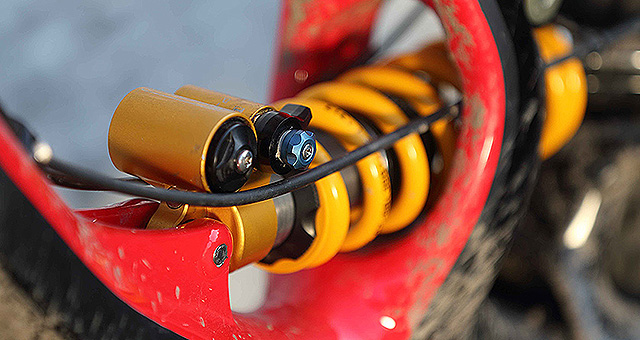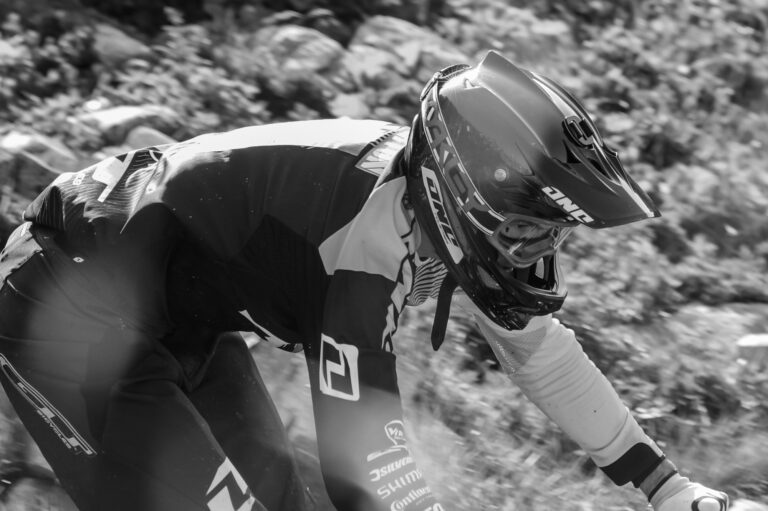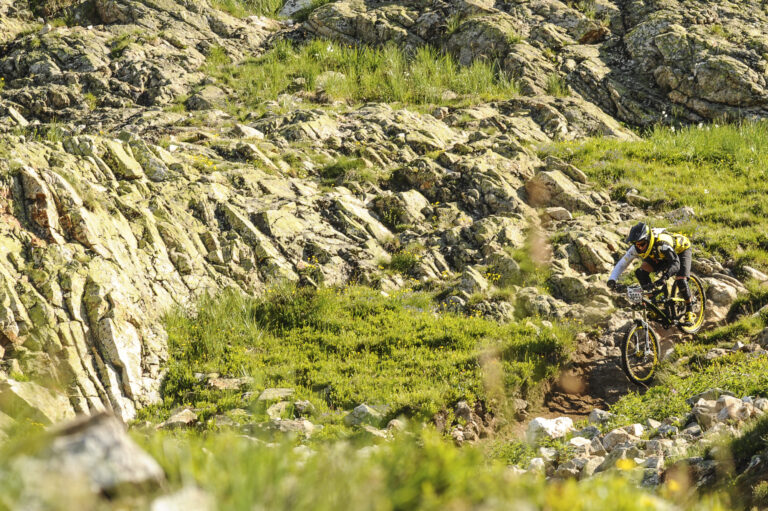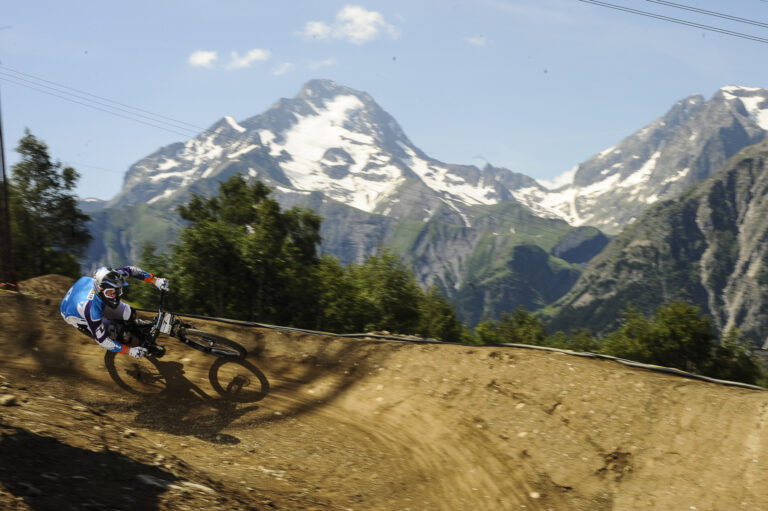In 2003 Raleigh had closed all its factories in the UK, which was the last of the big factories in Britain. The British bicycle industry dwindled, except for in a couple of little workshops in the corners of business parks, garden sheds and old stables, some of the mountain bike frame builders are working away building some of the most beautiful hand crafted frames I’ve ever seen. We decided that we needed to meet the guys behind such a craft. So we’ve teamed up with BikeMagic, and set sails towards the big smoke to meet up with frame builder, Ted James. You might have seen our feature on Ted James in our feature in issue #136.
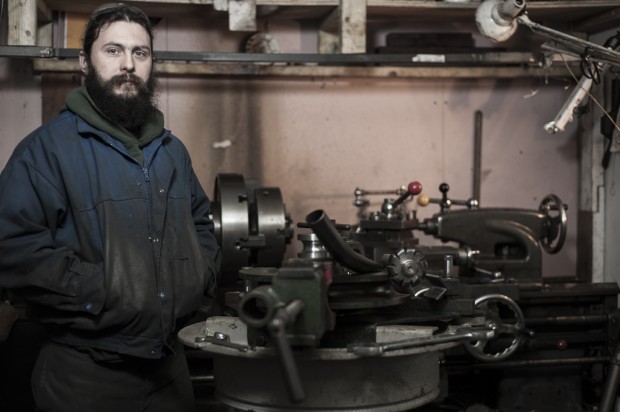
Dirt: So can you talk us through your background, how you got to be here, why you’re doing this? Big questions…
Ted James: I’ve been riding bikes all my life, starting with my dad as a kid, quite a lot of distance, racing mountain bikes from a young age – cross country and that. Back in the day at Penshurst, when you take your fully rigid bike with toe clips, race the cross country race, and then do the downhill and then do the trials event…
Before I was born!
Yeah, quite possibly, yeah. When I was 12, so that was dunno, 89, 90… All on the one 24” wheel Ridgeback 205 GS I think it was, with pink plastic toe clips.
Proper retro stuff!
Before SPDs, and when they were first new, couldn’t afford that stuff, couldn’t afford suspension, it was just coming out then… So yeah, racing mountain bikes from a young age, always wanted to jump, always jumping, and throwing the bikes around, breaking them… So yeah… Always been thinking of ways to make bikes stronger or perform better. Trying out the DCD – Dave’s Chain Device, you remember those?
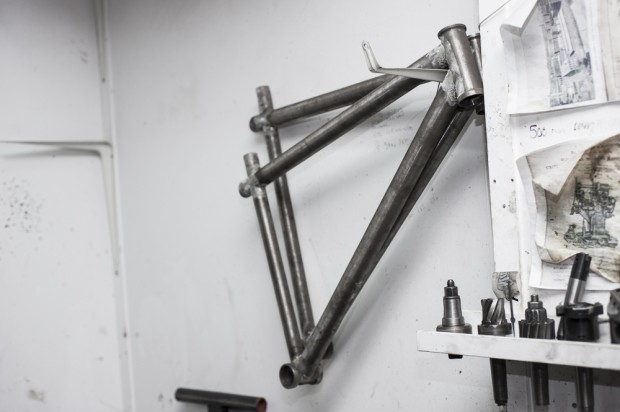
Yeah!
I think I tried to make my own one at the time ‘cause I couldn’t afford anything on my £5 a week pocket money, so yeah, always thinking of ways to improve the bike. Got into riding BMX ‘cause I was fed up with breaking wheels and derailleurs jumping mountain bikes… Got heavily into BMX for quite a long time, worked at a welding firm doing an apprenticeship welding, and was thinking about building BMX then, I started making some forks but I didn’t know enough about different materials – I knew people using 4130 chromoly, no idea where to get it from or… yeah.
Nothing happened with making or building frames until much later on, but I made my own pegs on a lathe in my lunch break, just some stainless pegs, was playing with the lathe, making sparks – doing lots of wrong things… I worked…my first job was Halfords, which was better than Sainsbury’s. They had a bike department, they had some good tools but no-one knew how to use them, so I went in there fixing bikes, assembling and fixing bikes and showing some of the other guys how to use some of the tools from watching my dad and fixing bikes at home.
I knew a lot about repairing bikes because I’d had quite a lot of jobs at bike shops in London for a long time working as bike mechanic in various different shops, and you know, putting my own bikes together, sort of customising and making little parts here and there but it was not till much later that I actually started to build – really thought that I would start building frames and I bought a small lathe, doing some little bits on that – repairing some frames, doing little welding bits on them.

I did a Dave Yates frame-building course with my little brother – he wanted to do it, and I’d been thinking I was about to try and build a frame, I thought that’d be perfect, yeah good. I knew how to weld but I didn’t know how to braze, so that was great, I thought I’d go along, learn some brazing, see how he put a frame together – his jigs and things, that was really good. I came away from that and built my first frame – for Vans actually. I was heavily involved with the fixed gear scene in London and tricks side of things.
I built this bike for Vans which was really good – good opportunity, built my first frame on my own for Vans, made my own jig, built this bike. And I got sponsored by Charge bikes for riding fixed gear, so I was riding with them a lot, and developing a new bike, talking with Nick about that, trying to develop a new design, so I was thinking more and more about designing frames and building. It just went from there, building up more tools and learning more stuff every day.
… And here we are.
Yeah, went from my first tiny lathe, now I’ve got two massive ones, a milling machine, learning how to use them and doing more and more, trying more and more stuff in-house, machining components and things rather than just using off the peg parts. Yeah, it ends up just as assembling then, you can be a welder and assemble some tubes and build a frame but what I really want to do is develop new stuff, try and push what can be done and make better bikes.
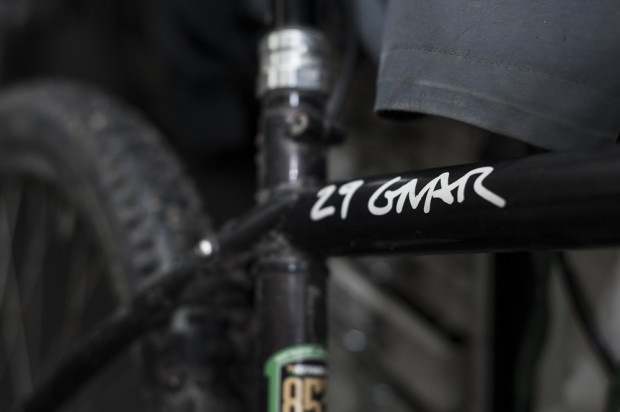
Yeah. So what do you think about the lack of knowledge that most riders have about the technology that goes into the bikes? About the tubing and the angles – most people don’t even know what wheelbase their bike is.
Yeah, there’s obviously a massive range of people who ride bikes, and some people have no idea at all – they buy a bike off the shelf and know nothing about it, they may not even know how to fix a puncture, and there are all kinds of different levels of knowledge from there to people who are building their own stuff. I’m learning more stuff every day, and even the top guys are learning more about different materials that can be used, and ways to work with it, so it is just a different amount of knowledge in the massive range of what you can know. It’s great if people do know more, I don’t like building bikes for people who don’t know what’s involved because it’s less special to them.
They don’t appreciate it?
You know, building a bike for somebody who really knows the amount of work that’s involved in it, and who knows what they want because they’re going to really appreciate it is good. So, I guess it’s good to educate people about what’s involved in building a bike, and how to look after it as well.

So what do you think it is that makes a bike really special? Can you put it down to angles, and stuff on paper? Or is it something in the ride that you can’t really formulise?
Could be a bit of everything, it depends what sort of bike you’re after, obviously it’s all about how it rides, and how you feel about that bike – you could have a really nice custom paint job that’s going to make you feel really good about it and be happy with it, you could have a rusty frame with some really good quality tubes built with good angles that just make it ride beautifully, and it won’t matter about the paint. A lot of my bikes tend to be like that! Shitty looking, but work well…

So do you reckon there is a formula for all the right angles, can you tell how a bike is going to ride before it’s on the ground?
Yeah, you can definitely tell how a bike is going to ride before it’s built; before it’s been ridden you can tell a good idea of how it’s going to ride. Obviously the more bikes you’ve ridden with different geometry, the more you’re going to know about how another one is going to ride, so I learnt a lot from riding BMX, trying different BMX frames, different angles, and learnt a lot from that.
There’s no set right angles or right geometry to have, it depends what you want from the bike, obviously a BMX race bike is going to be different to a street bike, a cross country bike completely different to a downhill bike, and every track is different, so there’s no one set right geometry to have. Components change all the time, different length travel forks, so geometry changes with components, as well.

Something that’s been dividing opinion in the office, do you reckon it matters on a bike if you’re going fast, or it feels like you’re going fast and pushing it?
Do you reckon it matters…?
Do you reckon it matters if you’re actually going fast or whether you just feel like you’re going fast because you’re pushing your bike on its limit?
Well I guess that depends, if you’re in a race or if you just want to go out for a nice enjoyable ride…
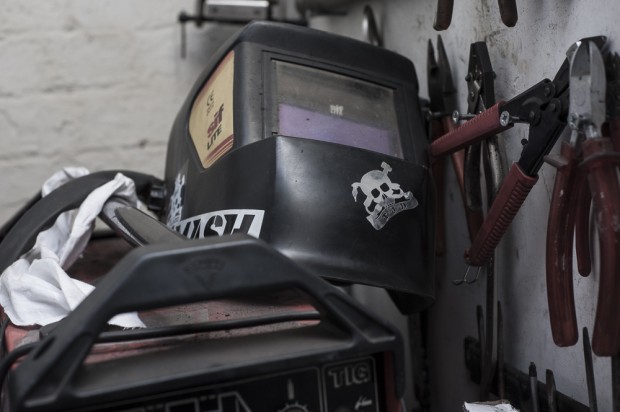
If you’re out there, out for a spin, would you rather actually be flying down a trail or be on a less capable bike but you’re really pushing it, getting loose?
It’s all about the feeling. If you’re going really fast but it feels boring because you’ve got 10” of travel and massive tyres, I don’t think it’s so fun… But you could be going a bit slower, on a fully rigid bike and having a lot more fun. Then I think it’s all about that.
And what do you reckon about 29ers then, because they can go a lot faster and feel a lot smoother? It’s harder to push the boundaries, I suppose…
I’m not sure I’d say it’s harder to push the boundaries; maybe you need bigger balls to do it. When I first saw 29ers come out, it didn’t interest me, it only seemed to make sense for big people – if you’re bigger it makes sense to have bigger wheels, but now I’ve found there are a lot of benefits to having bigger wheels if you can get the geometry right with them. That’s the difficulty – getting a good geometry to work well with the bigger wheels. If you’re a smaller person then it can be done.
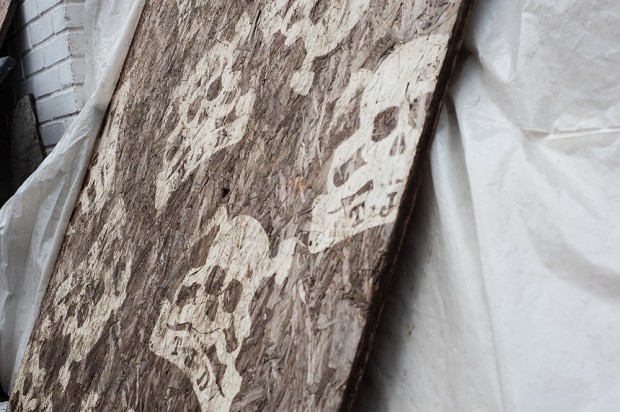
Yeah, I still need to do more riding to really see I can find some big disadvantages. It seems like there are a lot of advantages by having the big wheels. One thing is the turning, moving your gravity over from one side to the other, because your axle height is higher, it’s a bigger movement than with the smaller wheel.
There’s a lot more centripetal force keeping you stable as well. I suppose that’s why it feels a lot safer…?
Yeah, it’s if you need to flip into one turn, and then another, it’s getting the bike to flip over like that which is why racing motorbikes have small wheels. Flipping one-way to another quickly. That’s one thing with the 29er, because the axle height is higher that’s a bit more difficult. I was talking to…what’s his name…one the back of MBUK, advert for those bars…

Neil Donoghue… Talking to him about it, and he had a lot of negative things to say, he didn’t like the idea of the 29ers… He came up with some good points, actually, one of the main things that he said is that he goes out, ragging it, continuously squashing everything, chin on the stem, arse on the back wheel, and that’s more difficult on a 29er, because straight away, your stem’s higher from ground level, but then you can get your bottom bracket lower in relation to your axle height so then it becomes more stable.
So gearboxes vs. mechs. Do you reckon the rear mech is a massively flawed design?
I’ve…got extremely annoyed with them in the past, I think everybody has.
So that’s a yes then?
I mean derailleurs do work, for a lot of purposes they work really well, but there’s got to be a much better way to do it, I think. I get so annoyed with flappy chains, you can put all types of chain devices on it, you’re still going to flap around a bit. Newer technology has vastly improved…
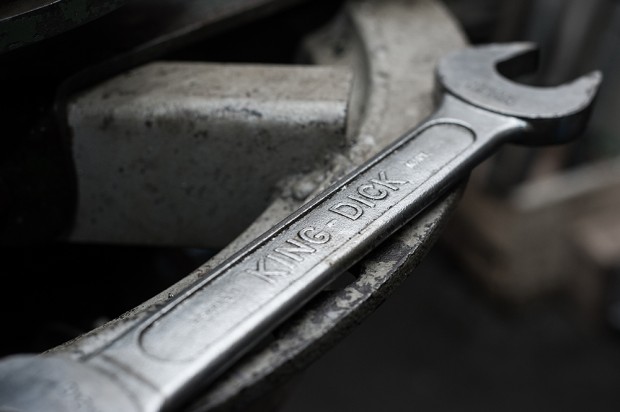
The clutch stuff…
You can still just hit it on a rock, and one of the new modern derailleurs… it’s a wearing part, we used to wear cassettes out all the time – riding in English mud and stuff, they just don’t last. You hit one of those mechs; you can’t afford to have a spare one of those mechs in your pocket.
So gearboxes – all enclosed, no muck can get in there, nothing to break.
I really like it, I was riding the Charge Duster 8, racing on that when I was sponsored by charge, before that I had a Rohloff hub and I was racing with that in Cross Country races and I really like it, just goes so well.
I did Mountain Mayhem one year, there was so much mud – people were just going into deep puddles, halfway up your axle in muddy puddles, and they were dragging their bikes out, trying to pull grass and stuff out of their derailleurs and cassettes, and trying to shift through gears that just aren’t working, and I just sink into a muddy puddle, track stand, shift into the low gear and cycle out of it, no sweat.
Everyone was there, swearing, sweating, massive pain in the arse. So I’m a massive fan of hub gears, before you start talking about gearbox – getting the weight off the back wheel is really good.

What do you reckon about belt drive from there? Are you a fan of belt drive, or do you prefer chains?
I’ve not had a good test of belt drives; I thought about it for this bike – the 29gnar because you wouldn’t need to split the frame to get the belt in there, I thought it might be something to think about. But I wouldn’t be able to get it in there because of the clearance issues – too wide, and the cost of it as well… It’s something that I wouldn’t have been able to do. On that, I was just scraping pennies to get it together I had to make some bits for the insides of my old Shiver forks to make them run a 29” wheel without it hitting the crown, that’s the way I had to get it running.
Couple more questions then, what’s the future for you? Ah, yeah, belt drives…
I’d like to test them out, and see how they really work in mud and things I’m a bit unsure, chains work well.
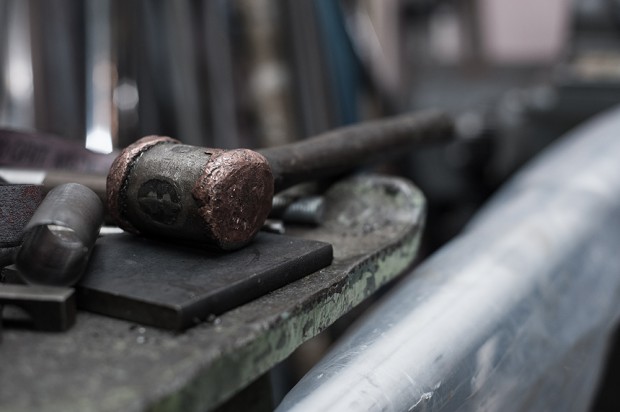
Not flawed… Snap occasionally…
Wear out a bit quick…
Over years you’re going to wear both, aren’t you?
I bought a chain on that, it’s only been three months or something and the chain has completely gone. Been riding quite hard…

Yeah, I can see… What’s the future for you then?
New workshop in Stroud, more riding, yeah.
New workshop in Stroud?
Yeah, new workshop in Stroud, three times the size, building a factory… Just always working on doing more in-house, being able to do more and more different things, improve ways of building, designs of bikes, I want to do a full suspension gearbox bike as well as improve my design of the gearbox system I have already made, do a lot more mountain bikes – being in London there are always people wanting fixed-gear bikes, and I want to build more mountain bikes and BMX’s. It’s what I really love, and what I’m really into, so being able to build bikes and test them in hills close by is going to be amazing. Wales across the river…
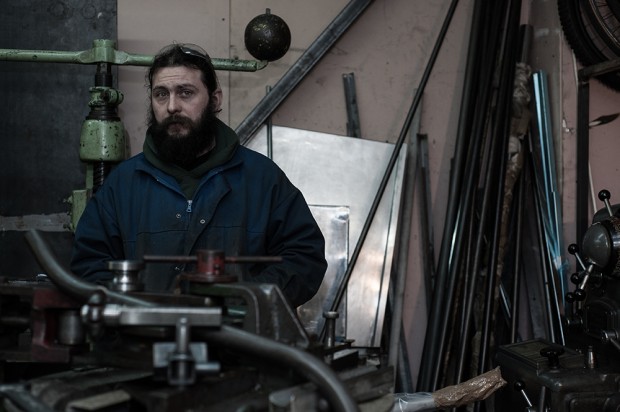
What do you reckon the future for your bikes is then? Are you staying with steel and some clean-lined hard-tails?
For the moment, I’m going to stick mainly with steel, I have tried working with titanium, I’ve done my first titanium bike but I think I’m going to be sticking mainly with steel. Lots of hardtails, but I want to work on some full sus as well. I do a lot of one off custom builds but I want to do some production models myself – produce them myself but do some ‘stock’ models – more bikes, less choice…
Off the shelf.
More affordable is what I’m trying to work on…
Easier for you – you can start doing batches…?
Yeah, it’s just getting the money to buy all the tubes in that’s the difficult thing… But that’s what I’m working towards.
Cheers Ted!
Check out Ted’s website out here.



